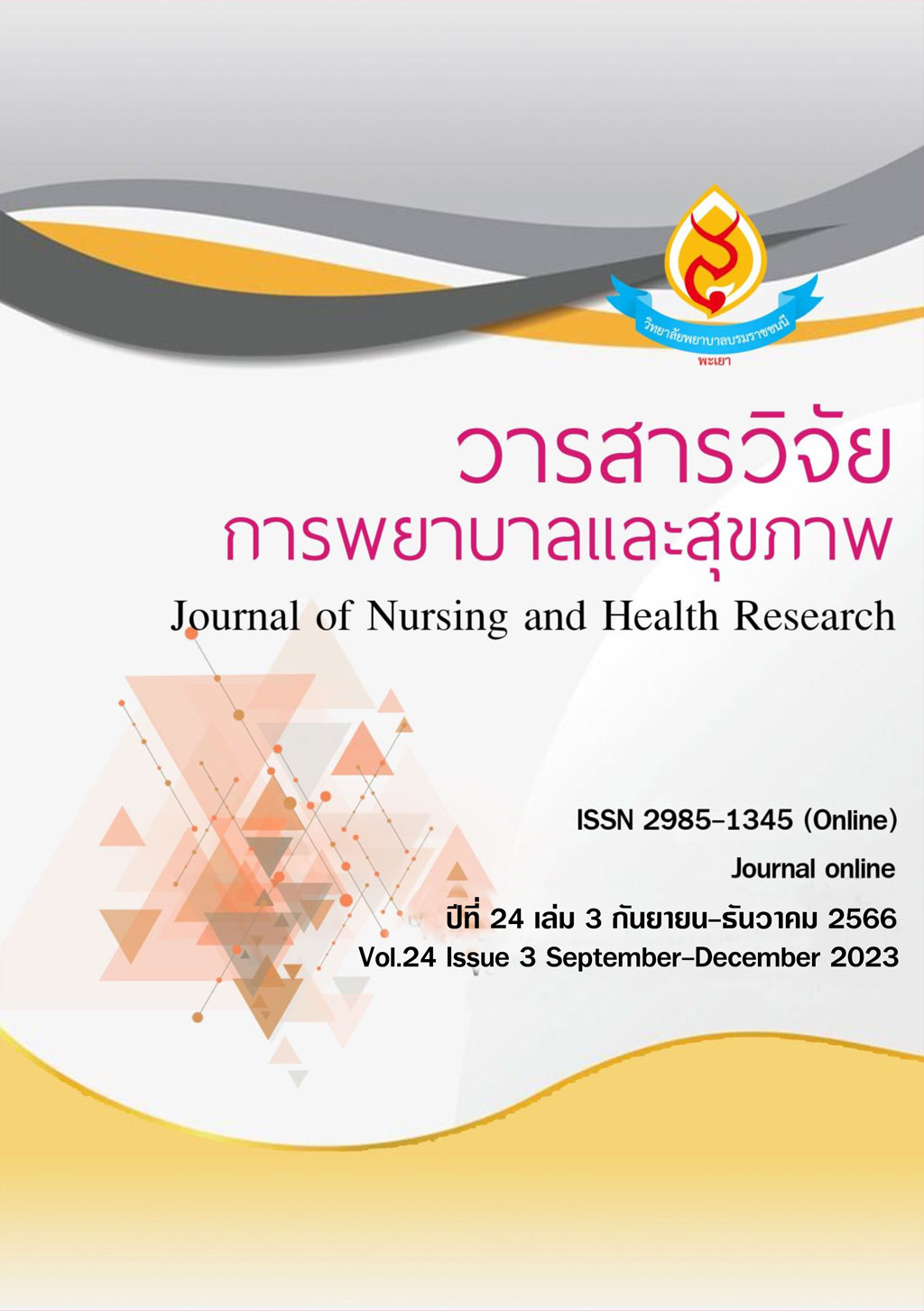ระดับความเครียดและการจัดการความเครียดเกี่ยวกับการศึกษาต่อในระดับอุดมศึกษา ของนักเรียนชั้นมัธยมศึกษาปีที่ 6
คำสำคัญ:
ระดับความเครียด, การจัดการความเครียด, นักเรียนมัธยมศึกษาปีที่ 6บทคัดย่อ
นักเรียนชั้นมัธยมศึกษามีการแข่งขันทางวิชาการสูง เนื่องจากต้องเตรียมความพร้อมเพื่อการแข่งขันเข้าศึกษาต่อในระดับอุดมศึกษาและส่งผลต่อความเครียดที่มาจากปัจจัยร่วมหลายประการ การศึกษาครั้งนี้มีวัตถุประสงค์
เพื่อศึกษาระดับความเครียด การจัดการความเครียด และปัจจัยที่มีความสัมพันธ์กับความเครียด กลุ่มตัวอย่าง คือ นักเรียนชั้นมัธยมศึกษาปีที่ 6 จำนวน 250 คน เครื่องมือในการเก็บรวบรวมข้อมูล ประกอบด้วย แบบสอบถามข้อมูลส่วนบุคคล แบบสอบถามความเครียด และแบบสอบถามการจัดการความเครียดของนักเรียนชั้นมัธยมศึกษาปีที่ 6 ทดสอบความเชื่อมั่นด้วยค่าสัมประสิทธิ์อัลฟ่าของครอนบาค เท่ากับ .86 และ .75 ตามลำดับ วิเคราะห์ข้อมูลด้วยสถิติเชิงพรรณนา หาความสัมพันธ์ด้วยสถิติไคสแควร์และค่าสหสัมพันธ์ของเพียร์สัน ผลการศึกษา พบว่า กลุ่มตัวอย่าง
มีระดับความเครียดอยู่ในระดับมากที่สุด ร้อยละ 46.80 และมีการจัดการความเครียดอยู่ในระดับปานกลาง ร้อยละ 88.40 นอกจากนี้มีการจัดการความเครียดแบบมุ่งแก้ปัญหาและแบบทำกิจกรรมทดแทนอยู่ในระดับปานกลาง ส่วนแบบมุ่งจัดการอารมณ์อยู่ในระดับต่ำ ผลการวิเคราะห์ความสัมพันธ์ พบว่า กลุ่มการเรียนและคณะวิชาที่ประสงค์จะเข้าศึกษาเป็นอันดับแรก มีความสัมพันธ์กับความเครียด อย่างมีนัยสำคัญทางสถิติ (p<.001) ในขณะที่ผลการเรียน มีความสัมพันธ์ทางลบกับความเครียด อย่างมีนัยสำคัญทางสถิติ (r=-0.264, p<.001) ดังนั้นผลการศึกษานี้เป็นข้อมูลให้ผู้ที่เกี่ยวข้องใช้ในการจัดกิจกรรมเพื่อการลดระดับความเครียดในนักเรียนให้เหมาะสมต่อไป
เอกสารอ้างอิง
กรมสุขภาพจิต. (2555). คู่มือคลายเครียด (ฉบับปรับปรุงใหม่). สืบค้นเมื่อ 1 พฤษภาคม 2566, จาก https://dmh.go.th/ebook/result2.asp?id=345.
กรมสุขภาพจิต. (2565). สภาวะอารมณ์ที่ไม่คงที่ในวัยรุ่น. สืบค้นเมื่อ 19 ตุลาคม 2566, จาก https://dmh.go.th/news/view.asp?id=2504
กีรติ ผลิรัตน์. (2557). ความเครียดของนักเรียนมัธยมศึกษาตอนปลายในเขตกรุงเทพมหานครที่เรียนกวดวิชาเพื่อศึกษาต่อในระดับอุดมศึกษา. วารสารศึกษาศาสตร์ มหาวิทยาลัยบูรพา, 32(2), 13-28.
ชนิกานต์ ขำเหมือน. (2558). ความชุกและปัจจัยที่เกี่ยวข้องกับความเครียดของนักเรียนชั้นมัธยมศึกษาปีที่ 6 โรงเรียนบุรีรัมย์พิทยาคม (วิทยานิพนธ์ปริญญาวิทยาศาสตร์มหาบัณฑิต). กรุงเทพฯ: จุฬาลงกรณ์มหาวิทยาลัย.
ดวงพร สุรพงษ์พิวัฒนะ. (2565). เคล็ดลับบอกลาความเครียด. สืบค้นเมื่อ 19 ตุลาคม 2566, จาก https://dmh.go.th/news/view.asp?id=2469.
นิธิสนี รุจิรังสีเจริญ, นิดา ลิ้มสุวรรณ, ศิริไชย หงส์สงวนศรี และ บัญญัติ ยงย่วน. (2564) ปัจจัยที่สัมพันธ์กับระดับความเครียดของนักเรียนระดับมัธยมศึกษา. วารสารสมาคมจิตแพทย์แห่งประเทศไทย, 66(1), 53-68.
เนตรดาว ปทุมพร และ นวพล นนทภา. (2563). การศึกษาความเชื่อของครูเกี่ยวกับการจัดการเรียนรู้ที่ส่งผลต่อเจตคติทางคณิตศาสตร์ของนักเรียนชั้นมัธยมศึกษาตอนต้น. วารสารมหาวิทยาลัยราชภัฏนครราชสีมา,14(3) , 151-158.
โรจนกร ลือมงคลชัย. (2564). โมเดลความสัมพันธ์เชิงสาเหตุความเครียดในการเรียนของนักเรียนมัธยมศึกษาที่มีการเรียนการสอนออนไลน์ในช่วงการระบาดของโรคโควิด-19 ในโรงเรียนเมืองพญาแลวิทยา จังหวัดชัยภูมิ.วารสารบัณฑิตศึกษามหาจุฬาขอนแก่น, 8(2), 117-129.
วนัญญา แก้วแก้วปาน. (2564,). การศึกษาความเครียดของนักเรียนวัยรุ่นชั้นมัธยมศึกษาปีที่ 6 โรงเรียนสังกัดสำนักงานเขตพื้นที่การศึกษามัธยมศึกษาเขต 10 จังหวัดสมุทรสงคราม. วารสารศึกษาศาสตร์ มหาวิทยาลัยบูรพา, 32(2), 13-28.
วรรณกร พลพิชัย และ จันทรา อุ้ยเอง. (2561). การศึกษาความเครียดและวิธีเผชิญความเครียดของนักเรียนระดับมัธยมศึกษาตอนปลายในอำเภอเมือง จังหวัดตรัง. วารสารนาคบุตรปริทรรศน์ มหาวิทยาลัยราชภัฏนครศรีธรรมราช, 10(พิเศษ), 94-106.
สิประภา บุบผาวรรณา, ประจวบ แหลมหลัก และ อนุกูล มะโนทน. (2564).ปัจจัยที่มีความสัมพันธ์ต่อความเครียดในนักเรียนมัธยมศึกษาชั้นปีที่ 6 จังหวัดพะเยา.วารสารวิชาการสาธารณสุขชุมชน. 7(4), 128-140.
สุนีย์ กันแจ่ม, เผด็จการ กันแจ่ม, ธนโชติ เฉลยสาร, กาญจนา วันหน่อแก้ว, จันทนา แซ่จ๋าว, น้ำทิพย์ วังซ้าย, … พัชรินทร์ ตินเขียว. (2565).ปัจจัยที่มีความสัมพันธ์กับความเครียดและการจัดการความเครียดของวัยรุ่นในเขตอำเภอเมืองจังหวัดอุตรดิตถ์. วารสารวิชาการวิทยาศาสตร์และวิทยาศาสตร์ประยุกต์.2565(2), 1-10.
สุวัฒน์ มหัตนิรันดร์กุล, วนิดา พุ่มไพศาลชัย และ พิมพ์มาศ ตาปัญญา. (2541). การสร้างแบบวัดความเครียดสวนปรุง. วารสารสวนปรุง. 13(3), 1-20.
สำนักงานเขตพื้นที่การศึกษามัธยมศึกษานครราชสีมา. (2566). ระบบสารสนเทศข้อมูลนักเรียน. สืบค้นเมื่อ 10 มิถุนายน 2566, จาก https://bigdata.mattayom31.go.th/info/index.php
อนุพงศ์ จันทร์จุฬา และ ซัยฟุดดีน ชำนาญ. (2559). ความเครียดและการเผชิญความเครียดของผู้ป่วยชายที่เข้ารับการบำบัดรักษายาเสพติดระยะฟื้นฟูสมรรถภาพโรงพยาบาลธัญญารักษ์สงขลา. กลุ่มภารกิจบริการวิชาการ โรงพยาบาลธัญญารักษ์สงขลา กรมการแพทย์ กระทรวงสาธารณสุข.
Best, J. W. (1993). Research in Education. Boston. MA: Allyn and Bacon.
Lazarus, R. S. & Folkman, S. (1984). Stress coping and appraisal. New York: Springer.
Glass, T. A., & McAtee, M. J. (2006). Behavioral science at the crossroads in public health: extending horizons, envisioning the future. Social Science Medicine, 62(7), 1650–1671.
Eppelmann, L., Parzer, P., Lenzen, C., Buerger, A., Haffner, J., Resen, F., … Kaess, M. (2016). Stress, coping and emotional and behavioral problems among German high school students. Mental Health & Prevention, 4(2), 7-81.
Taro Yamane. (1973). Statistics: an introductory analysis. New York: New York: Harper & Row.
ดาวน์โหลด
เผยแพร่แล้ว
รูปแบบการอ้างอิง
ฉบับ
ประเภทบทความ
สัญญาอนุญาต
ลิขสิทธิ์ (c) 2023 วารสารวิจัยการพยาบาลและสุขภาพ

อนุญาตภายใต้เงื่อนไข Creative Commons Attribution-NonCommercial-NoDerivatives 4.0 International License.



